“…as if refusing to be caught / In any singular vision of my eye / Or in the nets and cages of my thought, / They tower up, shatter, and madden space / With their divergences, are each alone / Swallowed from sight.”
— Richard Wilbur, An Event (excerpt)
In the last weeks, my wife and I have taken to a winter ritual that few of our Berlin neighbours understand. We prepare for it when the sun is sending its oblique rays from beneath the clouds on the western evening sky, strikingly colourful in this season, when the air becomes colder but the colours warmer, often a mix of gold and light violet like on medieval altar paintings. When dusk starts to fall, we get on our bikes and head off to the Grunewald city forest which starts a five minutes ride away.
The dance of the crows on that cool evening in the forest, was the dance of nameless ragged shapes—a Brownian movement of giant croaking molecules, mixed with some lesser cackling jackdaw atoms. The Brownian molecular movement revealing itself as the self-experience of the huge Psyche which this all is.
Oh yes, we are.
Our hikes into the woods started by chance—or, better—due to my way of organizing, or rather not organizing my writing after lunch break and a short nap, trying to squeeze in as much work as possible until darkness falls. When it is time to go to have enough light, I often don’t move because I need to watch the sun setting between all these drifting colours, making each fleeting moment unique and ephemerous. Every time I seem to encounter an eternal principle which I still have not fully grasped. So, it is mostly near dark when we go.
Last time we went, like always I clicked off the dynamo for my bike’s headlamp at the fringe of the woods. Inside the forest the immediate change of atmosphere felt like a soft shock. Branches and twigs populated the dim air, which smelled of forest, of a different realm to the world outside. There are still some logs lying across the path after the last huge storm more than a year ago, and we had to make careful detours. No sound in the air, apart from the traffic noise which became dimmer with every turn of our wheels.
Riding more deeply into the forest, we stopped talking and let our skin be greeted by that other skin, those innumerable encounters of air, moisture, wind, scent, molecules bumping on the mucous membranes inside our noses, and dim glow making our sight switch to peripheral vision. The leaves release their wet and cool scent that conveyed a gush of serenity to me. It seemed to touch a chord, a fiber of my body that is buried very deeply in my flesh, in my own particular way of being a chunk of earth. The forest was seemingly dead, barren, still. But I could sense that it lived under the winter torpor. I could smell that the soil was alive, and I sensed some other live faculty with a sense we cannot name yet – maybe the experience of being inside a huge whole which is not just a thing, but also a focused experience, a self, or a community of selves, just as I am.
As darkness fell more deeply during the minutes of our ride through the woods, our vision became stronger. The forest differentiated into fine grades of paler and darker gray, as though every bark, every twig, the cool soil emitted a weak light without any colours. All brightened up, where should have been deep darkness. Night in the forest was actually brighter than night on the well-lit city streets, where the lamps create that much more darkness where their shine doesn’t reach. If only our neighbours knew.
Then we heard the first faint caw, somewhere in the pale air above. A call coming from nowhere, swirling over our heads, quickly ripped apart by gushes of cold air. There was another one, and yet another one, slightly different in tone, closing in, and then more calls were coming, drawing closer, cawing, croaking, interspersed with some distant cackle. The crows had started to pour in and circle the sky above our heads.
We headed towards a small clearing which had become “ours” over the last years, had been our place of rest during long spring evenings, resonating with the chants of blackbird, song thrush, and nightingale. We had cared for a little oak during early spring and summer, coming nearly every evening to water it when rain had cut out for many months
The calls grew louder, coarser, ragged, rapped apart, raucous, intense, filling the sky with guttural voices. It was the song of winter, more raw, broken, and harsh than the multivoiced concert of summer. And still it was the same breathtaking experience of quivering life, of “the reservoirs of darkness stirred” (W. H. Auden, New Year Letter, London, Faber & Faber 1941). It was always the same life, and this same life was always spelt out by voices. We dropped our bikes to the ground. When we turned our heads up, the clearing opened like a window into the evening sky.
And there they were. The crows came in as pushed by a gust of wind sending black fragments across the air. The sky filled with voice, and with movement. Black bodies, stretched and bent, pointed wings flapping, whirling about, rolling over one another, sweeping around in sudden bends and brusk loops. The flock passed and curved, then disappeared over the pines and the barren maple trees, only to turn back from behind our backs, merging with another group in the air above. There where more voices, coming from different directions, smaller groups, singular individuals. It was a huge gathering, with crows coming in obviously from all over the south-western part of the city, dozens, hundreds, maybe thousands of voices and wings making the sky crack.
This was not a small flock occasionally choosing these parts of the forest as a roost for chilly nights, but a major, and ecologically important, agglomeration. A significant part of the crow population of the capital had chosen our summer clearing and the adjacent woods as resting place for the night. There were huge numbers of individuals, and at the same time more than numbers, more than many single individuals but one compact mass, a wall of sound, compacting with everything else in the pale light. The air became crow, rook, and jackdaw.
The flock aggregated, dissolved, merged again. The birds flew close curves all at once, their wings tearing apart the cool air with a hissing sound which made me feel the smooth and cool hard outer shell of their body feathers against the air on my own skin. There were at least three species, discernable by their calls: Hooded Crows, which are rather common in the capital, feeding on everything they find in the city. There were Rooks, which have become pretty rare in Berlin, and which travel mainly outward to the countryside to feed, but suffer intensely from an industrial agriculture that has been made plain deadly for all life that are not crops. And there were Jackdaws throwing the occasional mischievous gackle into the coarse screams of the crows.
In wintertime, huge flocks of crows are a spectacular, albeit still pretty regular phenomenon in the German capital. For some time, I had believed that we were witnessing the whole Berlin crow population settling in our trees. But I learned that there are several of these roosting zones, and they are not always as romantically remote as the one we are visiting in the evenings. There is another huge group, around four thousand individuals, gathering right in the city centre. These birds flock together on a highrise near the Spree river in the hip Friedrichshain/Kreuzberg borough, then start swirling and cawing, and ultimately settle around the Prussian Dome and the construction site of the city castle.
In the brightly lit city centre the atmosphere is different from the silent forest. But the existential lesson is the same: The world is continuously giving birth to itself, and I can be a joyful part of it. For me, the feeling is even stronger amid concrete, steel, tar, glaring lights and junk, and for many tourists, and birdspotters, alike. Rugged feathers stir the air and create a primordial reaction in the chemistry of the world, a phase shift, where inward experiences coalesce into visible, and audible shapes, and where the sensual presence of bodies creates a space of feeling. We cannot escape this, because that is the principle we are created from.
There are other roosting places distributed around the city area. The weirdest is inside the central terminal of TXL International Airport. The terminal, constructed in the 1970s, is built as an octogonal shape around an interior open space, mainly for parking cars. In the middle of the car park a massive scaffold made from metal bars raises 20 meters up in the air. From the outside it is covered with oversize advertisements on tarps. The inside belongs to the crows. Several thousand crouch in the metal framework on cold winter nights.
Around the airport, the birds share the vast expanses of space among the runways and taxiways with the aircraft. They rarely cause trouble—being so smart that they wait to fly across the runways unless a plane has taken off or landed. There is even a rookery close by–the typical multi-nest-colony where rooks raise their chicks (hooded crows, in contrast, breed in pairs). Rooks need the protein-rich diet found on the meadows between the airport lanes (insects, mice, worms) in order to raise their young. On some occasions in the early 2000s, fire fighters have tried to destroy their nests using hoses, but the birds are still there. By now, rooks are strongly protected, and can’t be shot at with watercannons.
We had laid down. It was chilly, but made it easier to watch the sky. And it made it easier to feel like a part. We gazed upwards, lying on the irregularly bunches of half-frozen grass, our hair making light noises on the soil. The crows were drawn back and forth across the evening sky as though they were fine debris drifting in the ocean, swooshing through a strait, forming eddies at the fringes, combining into loops and pools, rushing past. They floated about as though they were whirling leaves which the autumn has forgotten in a street corner in front of a closed shop, shutters down, and which are taken up by the wind and distributed over the sky. The birds rained through space like ash dragged up from a fire and fragmented by the air, black splinters filing the void. They fluttered about like bats emerging from a tropical cave, from some distance are indistinguishable from bellowing smoke.
It felt as though the swirling and dashing and dancing crows were the void self-differentiating into solid bodies which each had goals and needs, which each had an own voice and speed, a unique way of ripping apart the invisible silk screen of the air with a knife-sharp loop. And I was thinking that this, the self-differentiation of the void into individuals which each asserted themselves, and which for this self assertion needed the air, and the trees, and the darkness, and the wind, and the others, and us, their admirers, was the reason this whole dance had such a joyful effect on us.
Something seemed infinitely right. A self-searching and self-finding, a being searched and being found, a reaching out and meeting and being met by another warm body. And at the same time, it was the dance of nameless ragged shapes, a Brownian movement of giant croaking molecules, mixed with some lesser cackling jackdaw atoms. It was both, and it was one through the other: The Brownian molecular movement revealing itself as the self-experience of the huge Psyche which this all is.
The swirling crows, their raucous cries filling the dome of chilly air, are but one force which reminds us of this. They are a force which we can grasp easily because we have a body as they do. For this reason, as research into mirror neurons in our brains has shown, their experiences are accessible for us because we literally we feel them in our own bodies. But in a larger truth everything is psyche, because everything is body. The setting sun, drowning in an aura of gold and crimson. The shy rustling of wet leaves under our soles. The crisp air, sparkling with tiny droplets, each one making a fine impact on our mucuous membranes. The clefts and wrinkles in the pines’ barks. The cold crystals, composing the soil.
These kinds of revelations made us, my wife and me, hug one another. Every time we came here on a winter night was a very special insight into. We also needed some warmth. We were there on the damp floor slightly glazed over with icy crystals, staring into the void that filled itself with presence and purpose, because it filled itself with bodies with needs and desires. And then it emptied again. We moved a bit closer, huddled on the forest floor, where we had spent many hours in the long evenings of summer, shone on by the light of the transparent stalks of the tall forest grasses, unmoved, in seeming eternity.
There it was: the meeting of two warm bodies, which is the source of all newness and transformation you can think of: the meeting of two bodies, two atoms bumping into one another, forming a new molecule, two flakes of ash compounding and building a layer of fertile minerals on the soil, two rooks deciding to settle plumage to plumage in the top of an old pine-tree. Being close to one another in an embrace was nothing different from being part of the eddies and streams that stir pure matter. It was a strange mixed experience of being very much alive and being very much part of a mineral world, the back chilled by the cold floor, the skin tickled by the cool evening mist.
The key to us being able to partake in all this and to know these insights is our body. It is the fact that the crows and jackdaws, as we are, truly are flakes of ash, and drops of water, made of the elements. They, and we, are weight in space that can bump into other weight, change its shape, suffer this change, yearn for expansion, recoil in retreat. We all know how it is to be matter, in all its forms and shapes, as solid soil, as liquid, as air, because we all share being matter. The crows, gathering and mixing, screaming and excited, before settling to close their eyes for a night’s sleep, where a key to the totality behind individual things, and behind my own individuality.
Stretched out on the forest floor we talked about one of those most famous philosophical papers of the 1980s, which made a huge splurge and became a sort of embodied principle of how a philosopher had to think: Thomas Nagel’s “How it is like to be a bat”. In it, Nagel basically “proved” that we could never know, that we had no connection at all into the bat’s mind. The noble prize novel writer J.M. Coetzee famously refuted Nagel’s rule of thought. Coetzee disagreed with the ensuing general suspicion that humans in their ways to relate to nature inevitably project their inner worlds onto something unknowable and probably emotionless and mute. For Coetzee, we could know what a bat (or a rook) is feeling when it loops over the sky, being full of life, because we know how it feels to be full of life: being full of life is living in joy.
Lying there under the constant rain of coarse calls, emanating from the whirling ash fragments populating the void, I thought that we should push Coetzees refutal of Nagel a bit further: We even know how it is to be matter, because we arematter, and being matter, we know how it feels to be matter, as our feeling is one reality of being matter. So, we know that to be matter means to be in full life, and full life means joy.
From this angle the crows are the air, they are not different from it, but one of its ways to be, or rather, to desire itself. The crow-being discovers something in the air that no other can, and at the same time reveals that all that moves, and swirls, and transforms, hence that all there is, is the same: swirling flakes of matter in a stream that carries them upward, devours them, crushes them, spits them out changed, rearranged, newborn; particles that deeply down are but eddies in the one huge swirl of streaming being; white as driving snow, transparent as the steady drop, ragged and fragmented as black feathers against the sky.
We can feel because the whole is an incessant mixing of bodies and energies, bound together and separated by the drive towards mutual fertilization. We can feel because this material world through uncountable re-arrangements feels every change happening upon it. Everything that happens makes a difference. It brings more or less fertility, more or less self-realization. Everything that happens is a change of the expression on the face which is this world, make the over-encompassing psyche stir.
Our thought has dismissed the clairvoyance of older times when men were convinced that the visible was a sign of something intelligible, a power with which we could not communicate directly (because it is the same power forming ourselves). The flight, and the calls, of crows and ravens were interpreted by roman augurs, who would be summoned upon important events, in order to balance an urgent political decision with the bigger cosmic forces. To do this, the priest, the augur, would design a rectangle in the sand, or in a room, and face southeast or east, and watch.
What would an augur, hunkering in the freezing Grunewald Forest, read in the circling birds above? Would he read that it is time to go home and be kind to one another, to be grateful for a heated place to sleep, to be grateful to be part of the vast community of bodies? Would he gather from the caws and croaks that everything has voice, and that everyone is needed to be heard? Would he understand that the whole meshwork of unfolding processes, in which reality manifests itself, is infinitely precious, and invincibly strong? Would the priest resume the message of the black birds in that we need to find less laws and feel more? Or would he just sit in silence and understand that all the birds call for, circling overhead, chasing one another, flocking and dissolving, is a constant current of love towards everything that is, so that it can hear itself, be heard by the others, and continue unfolding?
Huge flocks of crows such as the one I am visiting in the evenings pale in comparison to how many of these birds invaded the German capital in the 1970s winters. Ornithologists assume that then there were 60,000 or more crows gathering in various parts in the city. But in the last twenty years the numbers have crashed. The rook population halved between the 1990s and the early 2000s. Today, the TXL airport rookery is the only one left in the city. The number of Hooded Crows broke down as well. It declined between 2004 and 2014 by a factor of four or five, leaving about 5000 breeding pairs in the city, for now. According to the ornithologist Hans-Jürgen Stork, who for many years led the NABU, the major german nature protection NGO, this is due to massive breakdowns in crow populations farther east, which once all gathered in the German capital in order to survive the winter. Industrial agriculture has cleared the life off the lands even there, in Poland and Russia.
Is the stirring of the soul we were witnessing as the air sang with coarse calls doomed to stop soon? Can we humans exist without soul? I am afraid that as we are sending the crow peoples away, we are not only impoverishing ecosystems, disrupting foodchains (hence ultimately weakening that on whose receiving end we sit). We are not simply destroying an individual way of being (the trickster-style of the folks of the Corvusgenus). We are directly interfering with soul. We are messing with our own soul, shrinking our own psyche, as this is not separate from the huge encompassing one (which ecopsychologist David Abram so aptly labels the “more-than-human-world” https://www.humansandnature.org/to-be-human-david-abram). We are ruining soul, and with it the chances that soul replenishes and rejuvenates from the desires of its body, which is matter. If we stop granting these beings space, they will go, and they will make the emptiness in ourselves to unbearable to survive.
Anthropologists know that Native American peoples held the crow and raven people in high estimation as genuine shamanic beings. They are superiorly intelligent (ravens pass the mirror-test of self-consciousness with ease), and in this intelligence so seemingly human, that they became the shamanic bird par excellence, obtaining a middlesman role between the normal world and the realm of the spirits. In the european folklore, a witch is accompanied by a raven. The familiar sits on her shoulder, chatting about the apt sorcery formula to apply, being by and far more intelligent than his half-human company.
There is a saying from those native peoples which sheds a light on what I intend when I say that if we destroy the manifest self-searching fertility, we inevitably destroy soul, and in it kill our own. The Sioux people, I have been told, think that if we do not express gratitude to the other beings with whom we share our breath, they will return to the world of the spirits. They will leave us, and we will remain, in silence and emptiness. Recently we have been told by top level entomologists that all the insects in the biosphere will have vanished in hundred years’ time. The Sioux view of our responsibility for the psyche of the world, and our failure to assume it, to me seems the sharpest explanation for what is happening. We cannot separate inner and outer realities. To pretend to be able to do so was a deadly mistake from the beginning.
Soul yearns for fertility wherever it settles. It is able to create a home wherever it is constrained to roost, and will do so, until it is completely destroyed. But still then, the principle of soul as the center around which reality unfolds is indestructible. Psyche is the primeval force; the world ceaselessly shuffles its fragments, allowing them to meet and combine, to be cast in new configurations, to overlap, cross-breed, creating fertile transformations where before were none. Psyche is not in particular need of humans. It plays them out and melts them to other forms, other fragments, other compounds. It likes to mold stones and splinters as eagerly, and with as much fervour of feeling. It can wait until universes have formed and contracted, and formed again. It knows no time, only desire, which is the source of all time.
Silence fell over the barren trees. We were seriously cold. The birds had vanished into the trees. Here and there we could hear a faint hustling where a bird was readjusting his weight on a branch, flapping wings, making the silky primary feathers rustle, rubbing his plumage on the bark or on another bird. The silence had come suddenly, as moments before there still had been considerably rumour in the sky, calls here and there, singing feathers. The decline in numbers from many hundreds birds flying to only few dozen had been nearly unperceivable. The shift from only a few to none was clear cut.
We heard some low-frequency stirring beneath the trees and knew that the wild boar were beginning to move out. We stretched our numbed limbs and pulled the bikes up from the forest floor. Also, the poodle stretched, front down and back elevated. While we had observed the birds, she had sat on her hindlegs, staring into the dark forest, as though expecting a large beast to emerge from the shadows.
We turned back in silence, headlights off, as our eyes had adapted perfectly to the darkness. As we rode along, softly bumping over roots half-raised from the soil, birds stirred in the trees overhead. Our passage left a wake of sound, a fine rustling of feathers, a sparkle of soft bodies. We moved and the world stirred, and folded back unto itself.
We stopped as we reached the end of the forest. For a few moments we could not see in the bright electrical lights. I switched on the headlamp, pulled the dog up under my arm, kissed my wife’s lips still so very warm. A kiss was probably the most accurate shorthand to the immense exchange of bodily encounters engendering transformation and making things able to blossom. The most permanent gesture. I said a silent thanks to the spirit of the forest, to this sensual manifestation of the all-encompassing soul.
Andreas Weber
Berlin
Banner image: Dark Forest, Belgium (Photo by Pawel Malinowski, Flickr)


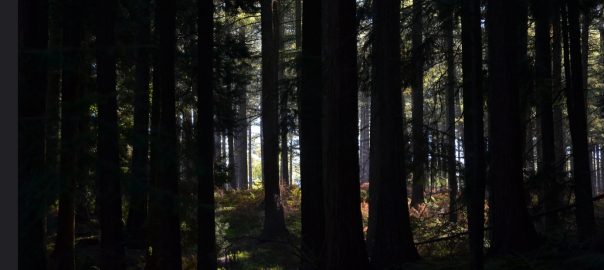
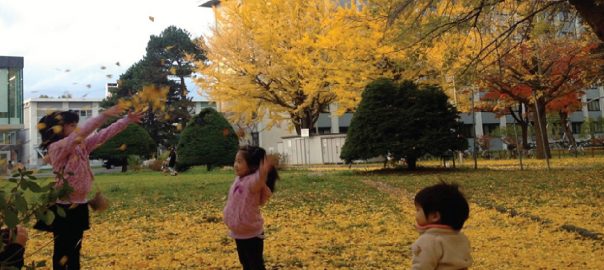
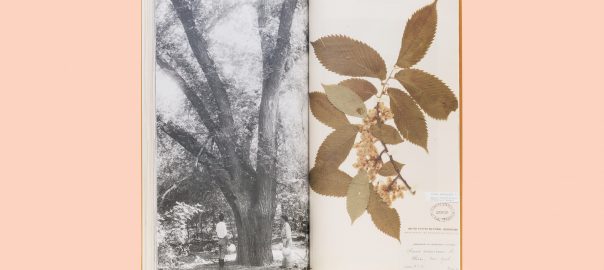
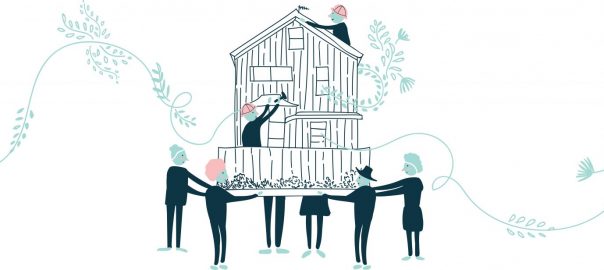
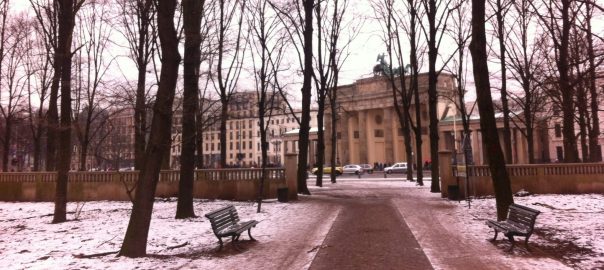
Leave a Reply